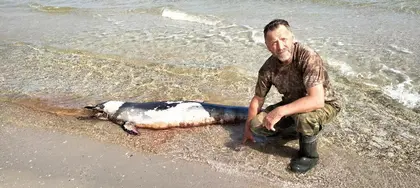On the night of June 6, the Nova Kakhovka dam on the Dnipro River was destroyed by Russians. The disaster swept through an area of the Kherson region inhabited by 40,000 people, pouring hundreds of tons of crude oil and other chemical waste into the Black Sea off the coast of the Odesa region. Over the next few days, animal carcasses and human corpses appeared along with the wreckage. Industrial waste, rich in heavy metals, which had been deposited at the bottom of the dam for years, was also washed into the sea.
So how polluted is the Black Sea now due to the flood from the dam disaster? Kyiv Post spoke to biologist Ivan Trifonovic Rusev, head of the Scientific Department of the Tuzly Estuaries National Nature Park, in the Odesa region.
What is the degree of pollution caused by this disaster? What are the implications for fauna and flora?
The consequences for fauna and flora are catastrophic. It especially affected reptiles and small mammals that could not actively migrate. Colonies of herons, as well as the nests of many bird species that were under water also suffered. Tens of thousands of chicks of various species and tens of thousands of reptiles, small mammals (voles, mice, shrews and other rodents) died. Many tailless amphibians – such as Danube crested newts – died. They were also washed up on the seashores in our Tuzly Estuaries National Park. They are listed in the Red Book of Ukraine.
The whole world was shocked by the scale of the ecological catastrophe and concerned about the level of pollution of the Black Sea.

Russian Missile Strike on Odesa Kills Four, Including Teenager
Pollution was massive. Chemical compounds were absorbed by phytoplankton and marine hydrobionts. The mollusk mussels and other species were particularly affected. Oil films covered large areas of the sea surface and this lethal for many fish species, especially mullets. Hydrobionts of what’s known as the epineuston, the surface layer of water, suffered especially.
Can the concentration of pollution be limited to a certain area of the sea, or might Turkey, Romania and Bulgaria also be affected?
Pollution mainly covered the northwestern part of the Black Sea. Romania and Bulgaria were slightly affected.
Despite this alarm, after two months the ban on swimming was lifted and the beaches of Odesa are full of bathers. Isn’t it dangerous for people to swim in the sea now?
Swimming is risky, because the water, especially in the Odesa Bay, is still polluted. There, breakwaters create stagnation and pollution accumulates.
But the sale of fish caught in the area is still prohibited. Why is it dangerous to eat fish caught in a contaminated area?
Eating fish from polluted water is, of course, dangerous. Because fish are repositories of chemical pollutants.
One gets the impression, perhaps erroneous, that the sea is able to dilute and neutralize any pollution.
Outside the Gulf of Odesa, where the energy of the sea is very strong due to wave phenomena and processes, the cleansing of the sea goes faster there. As, for example, in the water area of our national natural park, where after a week there was practically no evidence of the release of organic residues or any animals. However, it must be assumed that a lot of chemical pollution settled on the seabed in the shelf zone and affected the mollusks, since they are effective water filtrates and pollutant accumulators.
How long can a body of water like the Black Sea, which isn’t vast like the ocean, absorb the poisons brought in by such a flood?
The sea is a huge pollutant recycling factory. Everything happens quickly, but the part that is not processed by the sea simply settles to the bottom and is buried in its hydrogen sulfide part – at depth.
You can also highlight the text and press Ctrl + Enter






